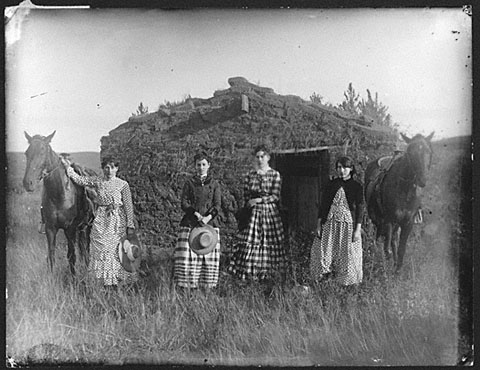
On May 20, 1862, President Abraham Lincoln signed the Homestead Act, opening government-owned land to small family farmers, who became known as “homesteaders.” It was a freedom opportunity for many, but also resulted in massive displacement of Native Americans and the growth of big railroad empires.
The act had two main goals: to sell off government land to ordinary citizens, and to use the land in what was considered an economically efficient manner. Previously, the U.S. government auctioned or sold public land in large lots that ordinary citizens could not afford to buy or manage. The Homestead Act was meant to favor the ordinary American, and to make assimilated citizens out of immigrants, African Americans, and, later, forced assimilation of Indians through the 1871 and 1887 Dawes Acts, supposedly for their own good.
The act gave “any person” who was the head of a family 160 acres to try farming for five years. The individual had to be at least 21 years old and was required to build a house on the property. Farmers could buy the 160 acres after six months at $1.25 an acre. Many homesteaders could not handle the hardships of frontier life and gave up before five years. If a homesteader quit, his or her land reverted back to the government and was offered to the public again. Ultimately, these lands often ended up as government property or in the hands of land speculators. If, after five years, the farmer could prove his or her homestead successful, the homesteader paid $18 for a “proved” certificate and received a deed to the land.
The Homestead Act allowed African Americans, persecuted and famine-struck immigrants, and even women a chance to seek freedom and a better life in the West. In the Reconstruction South during the 1870s, harsh racism pushed former slaves to seek refuge in the Midwest, taking advantage of the Homestead Act to try to start new lives there.
In the process, open land was turned into private property, and much of the land offered by the government was purchased by individuals acting as “fronts” for land speculators who sought access to the vast untapped mining, timber and water resources of the West.
Moreover, the beginnings of industrialization and the growing significance of railroads in the transport of goods skewed land distribution to the benefit of railroad companies. In the 10 years before passage of the Homestead Act, almost 128 million acres of land were granted to railroads, which often included the most agriculturally viable land. When land along railroad lines were opened up to the public, the land was often snapped up by speculators and later resold at high prices.
And ironically, in the search for freedom, homesteaders – and speculators – encroached on Native American territory, frequently in aggressive and bloody fashion. Many settlers and speculators began to agitate for expansion of homesteading into land that had been assigned to Indians under the 1851 Indian Appropriations Act. The government responded by stripping Indians of the last semblance of sovereignty they had by abolishing the reservation system as well as their honoring of tribes as separate entities from the United States.
Many settlers were not successful and left, but many stuck it out. The Homestead Act endured as the driving force for many Americans and immigrants seeking the “American dream.” It transformed the West, with small farms evolving into towns and even cities, with a network of railroads, and later highways, and industry springing up as well. It also triggered many conflicts between individual farmers and railroad companies who owned the majority of Western territory.
Although the act was officially repealed by Congress in 1976, one last title for 80 acres in Alaska was given to Kenneth Deardorf in 1979.
Photo: Four Chrisman sisters in front of a sod house in Goheen settlement in Custer County, Neb., 1886. All four sisters had their own separate plot of land. Like the Chrisman sisters, many women experienced autonomy in the West. Nebraska State Historical Society












Comments